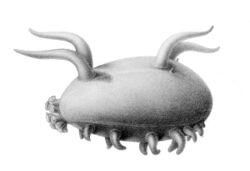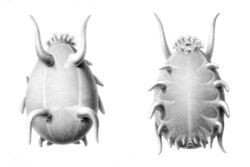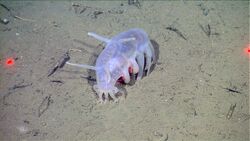Biology:Scotoplanes
| Scotoplanes | |
|---|---|

| |

| |
| Scotoplanes globosa | |
| Scientific classification | |
| Domain: | Eukaryota |
| Kingdom: | Animalia |
| Phylum: | Echinodermata |
| Class: | Holothuroidea |
| Order: | Elasipodida |
| Family: | Elpidiidae |
| Genus: | Scotoplanes Théel, 1882[1] |
| Species | |
| |
Scotoplanes is a genus of deep-sea sea cucumbers of the family Elpidiidae. Its species are commonly known as sea pigs.
Locomotion
Members of the Elpidiidae have particularly enlarged tube "feet" that have taken on a leg-like appearance, using water cavities within the skin to inflate and deflate thereby causing the appendages to move.[2] These appendages are different from the normal tube feet of the broader order of Elasipodida due the replacement of ampullae with dermal cavities to account for the larger size of the Elpidiidae tube feet. Scotoplanes move through the top layer of seafloor sediment and disrupt both the surface and the resident infauna as it feeds.[3] This type of movement is thought to be an adaptation to life on the soft floor of the deep-sea. These creatures, however, are able to swim when disturbed. Some species of Scotoplanes are benthopelagic and spend plenty of time in the water column. A frontal lobe as well as two anal lobes propel the sea pig through the water. Their tentacles help detect their surroundings while moving.[4]
Ecology
Scotoplanes live on deep ocean bottoms, specifically on the abyssal plain in the Atlantic, Pacific and Indian Oceans, typically at depths of over 1,200 to 5,000 meters (3,900 to 16,400 feet)[5][6] Some related species can be found in the Antarctic. Scotoplanes (and all deep-sea holothurians) are deposit feeders and obtain food by extracting organic particles from deep-sea mud. Scotoplanes globosa has been observed to demonstrate strong preferences for rich, organic food that has freshly fallen from the ocean's surface[7] and uses olfaction to locate preferred food sources such as whale corpses.[8] Scotoplanes, like many sea cucumbers, often occur in huge densities, sometimes numbering in the hundreds when observed. Early collections have recorded groups of up to 300-600 individuals. Sea pigs are also known to host different parasitic invertebrates, including gastropods (snails) and small tanaid crustaceans.[9]
Scotoplanes, like other sea cucumbers, host parasitic and commensal organisms. For example, it provides a shelter to juvenile crabs, Neolithodes diomedeae. It is known that such relationship benefits the crabs because they can reduce risks of predation when they are under the shelter.[10]
Scotoplanes are known to exhibit behavioral patterns of aggregation, where large numbers will aggregate either to feed or mate.[11]
Size
Scotoplanes can grow to 4 to 6 inches (10 to 15 centimeters) in length.[12] They are bilaterally symmetrical with six pairs of tube feet, which are largest at mid-body and smallest near the anus. Scotoplanes also have ten buccal tentacles lining the oral cavity.
Physiology
Scotoplanes are tiny and have their own defence mechanism to protect themselves from predators. Their skin contains a toxic chemical called holothurin which is poisonous to other creatures. They have external appendages which include tube feet, dorsal papillae, and buccal tentacles.
Like all echinoderms, Scotoplanes have a poorly developed respiratory system and they breathe from their anus. This refers to the lack of a respiratory tree. Their bodies are made for the deep seas and bringing them too close to the surface would cause them to disintegrate.[13] Also similar to other echinoderms is Scotoplanes nervous system, which consists of a network of nerves without ganglia.
Scotoplanes have unique reproductive systems that consist of one gonad in both female and male organisms. This means one ovary in females and one testis in males. This is different from most echinoderms. Also unique from most elasipodids is that active gametogenesis was observed in both females and males, pointing to a different reproduction strategy in Scotoplanes.
Similar to other echinoderms, Scotoplanes have a water vascular system. The dorsal papillae are similar histologically to Scotoplanes' tube feet, as both contain a large muscular water vascular canal in the center. Hydraulic pressure in these canals are responsible for the efficacy of the vascular system.[14]
Taxonomy
The genus includes the following species:[15]
- Scotoplanes angelicus
- Scotoplanes globosa
- Scotoplanes mutabilis
A study done provides histologic findings that these deep-sea dwelling sea pigs are similar to other holothuroidea, though there are few notable differences: most holothurians are sexually dioecious with sexes in separate individuals. Unlike other echinoderms, holothuroids possess only a single gonad. The water vascular system of holothuians is similar to other echinoderms, except the madreporite opens in the perivisceral coelom instead of in the external body wall.[16] In male Scotoplanes their aboral intestines have protozoa inside these cyst cavities.[16]
References
- ↑ Théel, H (1886). Report on the Holothurioidea dredged by HMS Challenger during the years 1873-76.
- ↑ Hansen, B. (1972). "Photographic evidence of a unique type of walking in deep-sea holothurians". Deep-Sea Research and Oceanographic Abstracts 19 (6): 461–462. doi:10.1016/0011-7471(72)90056-3. Bibcode: 1972DSRA...19..461H.
- ↑ Blake, James A.; Maciolek, Nancy J.; Ota, Allan Y.; Williams, Isabelle P. (2009-09-01). "Long-term benthic infaunal monitoring at a deep-ocean dredged material disposal site off Northern California" (in en). Deep Sea Research Part II: Topical Studies in Oceanography 56 (19–20): 1775–1803. doi:10.1016/j.dsr2.2009.05.021. Bibcode: 2009DSRII..56.1775B.
- ↑ Gebruk (1995): 95-102., A. V. (1995). "Locomotory organs in the elasipodid holothurians: functional-morphological and evolutionary approaches". Echinoderm Research: 95–102. ISBN 9789054105961. https://books.google.com/books?id=Pfb3lsIjLsEC&dq=Locomotory+organs+in+the+elasipodid+holothurians%3A+functional-morphological+and+evolutionary+approaches&pg=PA95.
- ↑ Barry, James P.; Taylor, Josi R.; Kuhnz, Linda A.; De Vogelaere, Andrew P. (2016-10-01). "Symbiosis between the holothurian Scotoplanes sp. A and the lithodid crab Neolithodes diomedeae on a featureless bathyal sediment plain" (in en). Marine Ecology 38 (2): e12396. doi:10.1111/maec.12396. ISSN 1439-0485. Bibcode: 2017MarEc..38E2396B.
- ↑ Llano, George Biology of the Antarctic Seas III, Volume 11 of Antarctic research series, Volume 3 of Biology of the Antarctic seas, Issue 1579 of Publication (National Research Council (U.S.))) American Geophysical Union, 1967, p. 57
- ↑ Miller, R. J.; Smith, C. R.; Demaster, D. J.; Fornes, W. L. (2000). "Feeding selectivity and rapid particle processing by deep-sea megafaunal deposit feeders: A 234Th tracer approach". Journal of Marine Research 58 (4): 653. doi:10.1357/002224000321511061.
- ↑ Pawson, DL; Vance, DJ (2005). "Rynkatorpa felderi, new species, from a bathyal hydrocarbon seep in the northern Gulf of Mexico (Echinodermata: Holothuroidea: Apodida)". Zootaxa 1050: 15–20. doi:10.11646/zootaxa.1050.1.2.
- ↑ Miller, Robert J.; Smith, Craig R.; Demaster, David J.; Fornes, William L. (2000-07-01). "Feeding selectivity and rapid particle processing by deep-sea megafaunal deposit feeders: A 234Th tracer approach". Journal of Marine Research 58 (4): 653–673. doi:10.1357/002224000321511061. http://www.ingentaselect.com/rpsv/cgi-bin/cgi?ini=xref&body=linker&reqdoi=10.1357/002224000321511061.[yes|permanent dead link|dead link}}]
- ↑ Barry, James P.; Taylor, Josi R.; Kuhnz, Linda A.; De Vogelaere, Andrew P. (2017). "Symbiosis between the holothurian Scotoplanes sp. A and the lithodid crab Neolithodes diomedeae on a featureless bathyal sediment plain". Marine Ecology 38 (2): e12396. doi:10.1111/maec.12396. Bibcode: 2017MarEc..38E2396B.
- ↑ Gutt, J.; Piepenburg, D. (1991). "Dense aggregations of three deep-sea holothurians in the southern Weddell Sea, Antarctica". Marine Ecology Progress Series 68 (3): 277–285. doi:10.3354/meps068277. ISSN 0171-8630.
- ↑ Bates, Mary (2014-06-16). "The Creature Feature: 10 Fun Facts About Sea Pigs". Wired. ISSN 1059-1028. https://www.wired.com/2014/06/the-creature-feature-10-fun-facts-about-sea-pigs/.
- ↑ Barry, James; Taylor, Josi; Kuhnz, Linda; De Vogelaere, Andrew (October 15, 2016). "Symbiosis between the holothurian Scotoplanes sp. A and the lithodid crab Neolithodes diomedeae on a featureless bathyal sediment plain". Marine Ecology 38 (2): e12396. doi:10.1111/maec.12396. Bibcode: 2017MarEc..38E2396B. https://doi.org/10.1111/maec.12396.
- ↑ LaDouceur, Elise E. B.; Kuhnz, Linda A.; Biggs, Christina; Bitondo, Alicia; Olhasso, Megan; Scott, Katherine L.; Murray, Michael (2021-08-06). "Histologic Examination of a Sea Pig (Scotoplanes sp.) Using Bright Field Light Microscopy" (in en). Journal of Marine Science and Engineering 9 (8): 848. doi:10.3390/jmse9080848. ISSN 2077-1312.
- ↑ MarineSpecies.org – Scotoplanes
- ↑ 16.0 16.1 LaDouceur, Elise E. B.; Kuhnz, Linda A.; Biggs, Christina; Bitondo, Alicia; Olhasso, Megan; Scott, Katherine L.; Murray, Michael (August 2021). "Histologic Examination of a Sea Pig (Scotoplanes sp.) Using Bright Field Light Microscopy" (in en). Journal of Marine Science and Engineering 9 (8): 848. doi:10.3390/jmse9080848.
 Text was copied from this source, which is available under a Creative Commons Attribution 4.0 International License.
Text was copied from this source, which is available under a Creative Commons Attribution 4.0 International License.
External links
- Scotoplanes article and photos on Echinoblog
- Sea pigs? Gross or cool? on Animal Planet website
- [1] Neptune Canada "Sea Pig Slow Dance"
- Scotoplanes as a refuge for crabs
Further reading
Ruhl, Henry A., and Kenneth L. Smith, Jr. "Go to Science." Science Magazine: Sign In. Science., 23 July 2004. Web. 1 May 2015. [1] Wikidata ☰ Q2327807 entry
 |
- ↑ Ruhl, Henry A.; Smith, Kenneth L. Jr. (23 July 2004). "Shifts in Deep-Sea Community Structure Linked to Climate and Food Supply". Science 305 (5683): 513–515. doi:10.1126/science.1099759. PMID 15273392. Bibcode: 2004Sci...305..513R.



